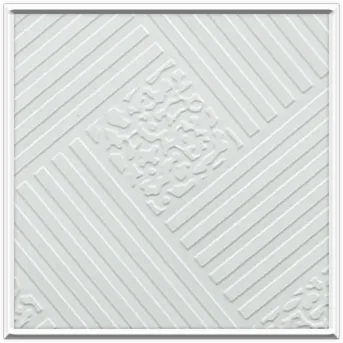Nov . 17, 2024 13:58 Back to list
Exploring the Aesthetics and Functionality of Ceiling Grid Designs in Modern Architecture
The Ceiling Grid A Vital Element in Modern Architecture
In the realm of modern architecture and interior design, the ceiling grid has emerged as a fundamental component that combines aesthetics with functionality. This grid system, typically made of lightweight metal or other pliable materials, serves as the framework for ceiling tiles or panels, providing not only structural support but also an opportunity for creative expression in space design.
The Ceiling Grid A Vital Element in Modern Architecture
One of the notable advantages of ceiling grids is their acoustic performance. Many ceiling tiles are specifically designed to reduce noise levels in a space, contributing to a more pleasant and productive environment. This is particularly crucial in open-plan offices or learning environments, where distractions can impede focus and collaboration. By incorporating sound-absorbing materials within the grid system, designers can significantly enhance the overall acoustic comfort of a space.
t ceiling grid

Additionally, ceiling grids provide opportunities for innovative lighting solutions. The grid can support various lighting fixtures, from panel lights to decorative pendants, giving designers the freedom to create unique lighting schemes that complement the overall décor. The flexibility offered by a grid system allows for the integration of natural and artificial lighting, enhancing the ambiance and functionality of the space.
From a design perspective, ceiling grids open up a multitude of possibilities. They can be painted or finished to match the interior style, allowing them to blend seamlessly with the overall aesthetic. Grids can also be used to create visual interest, such as geometric patterns or color contrasts, serving as a focal point within a room. The dynamism of ceiling grids encourages creativity, prompting architects and designers to explore unconventional ideas in their projects.
Moreover, the sustainability aspect of ceiling grids cannot be overlooked. Many manufacturers now offer eco-friendly materials and practices in the production of ceiling tiles and grid systems. This aligns with the growing trend toward sustainable design, where architects and builders are increasingly focused on minimizing their environmental impact. Using recyclable materials and energy-efficient designs, ceiling grids contribute to the overall sustainability of modern buildings.
In conclusion, ceiling grids play an essential role in contemporary architecture and design. Their functional benefits, combined with the potential for creative expression and sustainable practices, make them an indispensable element in both commercial and residential spaces. As buildings continue to evolve and adapt to new technologies and needs, the ceiling grid will undoubtedly remain a vital component of the architectural landscape, fostering innovative designs and enhancing user experience.
-
Quality Ceiling Trap Doors & Access Panels | Easy & Secure AccessNewsAug.30,2025
-
Durable Ceiling T Grid Systems | Easy InstallationNewsAug.29,2025
-
PVC Gypsum Ceiling: Durable, Laminated Tiles for Modern SpacesNewsAug.28,2025
-
Pvc Gypsum Ceiling Is DurableNewsAug.21,2025
-
Mineral Fiber Board Is DurableNewsAug.21,2025
-
Ceiling Tile Clip Reusable DesignNewsAug.21,2025







